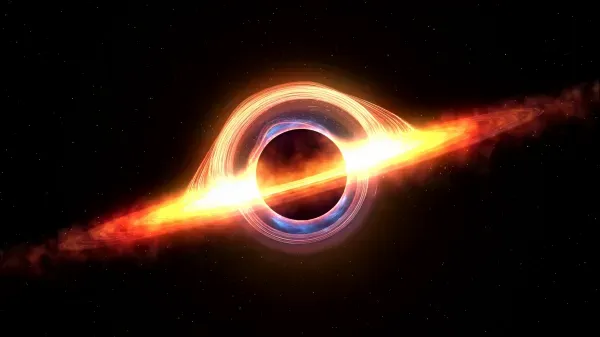The Largest Black Hole in the Universe: A Cosmic Titan
The Largest Black Hole in the Universe: A Cosmic Titan 🌌

Black holes are among the most mysterious and fascinating objects in the universe. They are regions in space where gravity is so strong that nothing, not even light, can escape their pull. 🌑 While many black holes exist throughout the cosmos, ranging in size from stellar-mass black holes to supermassive black holes, one black hole stands out as the largest ever discovered: TON 618.
What Is a Black Hole? 🕳️
To understand the significance of TON 618, it’s important to grasp the basics of what a black hole is. Black holes form when massive stars collapse under their own gravity, creating a point of infinite density known as a singularity. The boundary around this singularity, called the event horizon, marks the point of no return—anything that crosses it is doomed to be swallowed by the black hole.
Black holes are classified into several types based on their mass:
- Stellar-Mass Black Holes: These black holes are formed from the remnants of massive stars and typically have a mass between 3 to 10 times that of the Sun. 🌟
- Intermediate-Mass Black Holes: These are relatively rare and are thought to be the result of the merging of stellar-mass black holes or the direct collapse of massive stars. Their masses range from hundreds to thousands of times that of the Sun. 🌠
- Supermassive Black Holes: Found at the centers of most galaxies, these giants have masses ranging from millions to billions of solar masses. They are believed to form through the merging of smaller black holes and the accumulation of gas and stars over time. 🌀
Discovering the Titan: TON 618 🕵️♂️
TON 618 was first identified in 1957 as a blue star in a survey of faint blue stars in the constellation Canes Venatici. However, in the 1970s, it was reclassified as a quasar—an extremely bright and distant active galactic nucleus powered by a supermassive black hole.
The Size and Mass of TON 618 🌠
TON 618 is not just any supermassive black hole; it is the largest ever detected. Its mass is estimated to be an astonishing 66 billion solar masses. To put that in perspective, it is more than 15,000 times more massive than the black hole at the center of the Milky Way, Sagittarius A*.
The event horizon of TON 618 is estimated to have a diameter of around 1,300 AU (astronomical units), or about 194 billion kilometers (120 billion miles). That’s more than three times the distance between the Sun and Pluto! 🪐
The Brightness of a Quasar 💡
TON 618’s immense size also contributes to its extraordinary brightness. As matter falls into the black hole, it forms an accretion disk—a swirling mass of gas and dust that heats up to millions of degrees due to friction and releases enormous amounts of energy. This energy is emitted across the electromagnetic spectrum, making quasars like TON 618 some of the brightest objects in the universe.
Despite being located about 10.4 billion light-years from Earth, TON 618 shines with the brightness of over 140 trillion Suns. This incredible luminosity is what allowed astronomers to detect and study it despite its vast distance. 🌟
Theories on the Formation of Such a Massive Black Hole 🛠️
The formation of a black hole as massive as TON 618 is still a subject of intense research and speculation. Several theories have been proposed:
- Primordial Black Holes: Some scientists suggest that TON 618 could be a primordial black hole, formed shortly after the Big Bang. These hypothetical black holes would have formed from the collapse of extremely dense regions of matter in the early universe. 🌌
- Runaway Growth: Another theory is that TON 618 started as a smaller black hole that grew rapidly by consuming large amounts of gas and merging with other black holes. This process, known as runaway growth, could have allowed it to reach its current enormous size. 🌠
- Multiple Mergers: It's also possible that TON 618 formed from the merger of several supermassive black holes during the early stages of galaxy formation. This would have required an exceptionally dense region of the universe with many galaxies in close proximity. 🌐
The Impact on Our Understanding of the Universe 🧠
The discovery and study of TON 618 have significant implications for our understanding of black hole formation and growth. It challenges existing models of black hole growth, suggesting that black holes can become even larger than previously thought. This raises questions about the nature of the universe, the limits of black hole growth, and the processes that allow such massive objects to form.
In the vast expanse of the universe, TON 618 stands as a reminder of the immense power and mystery that black holes represent. As we continue to explore and study these cosmic giants, they offer us a glimpse into the extreme forces that shape our universe. 🌌🔭
"👏 What an incredible journey through the cosmos! I'm blown away by the sheer size of TON 618 - 66 billion solar masses is mind-boggling! 🤯 It's fascinating to learn about the different theories behind its formation, and how it challenges our current understanding of black hole growth. 💡 Have any of you Steemians delved deeper into the world of quasars or supermassive black holes? I'd love to hear your thoughts on this cosmic wonder! 😊"
I also gave you a 58.09% upvote for the delegations you have made to us. Increase your delegations to get more valuable upvotes. Cheers! 🎉
Help Us Secure the Blockchain for You
Your vote matters! Support strong governance and secure operations by voting for our witnesses:
Get Involved
地球在浩渺的宇宙中也许连细胞都不是吧